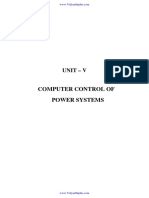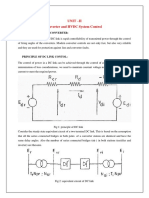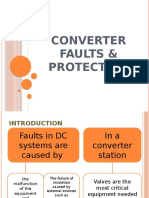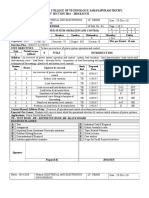0 ratings0% found this document useful (0 votes)
638 viewsUnit V: Computer Control of Power Systems
The document discusses the need for computer control of power systems through energy control centres. It describes the functions of an energy control centre, including system monitoring, state estimation, unit commitment and economic dispatch, automatic generation control, and reactive power management. The control centre aims to ensure reliable and affordable power supply by acquiring data, monitoring the system state, performing analysis like load forecasting and contingency analysis, and sending control signals to power system elements. A hierarchical structure of control centres consisting of central, regional and local levels is implemented to manage large power systems.
Uploaded by
Vishal KhumaarCopyright
© © All Rights Reserved
Available Formats
Download as PDF, TXT or read online on Scribd
0 ratings0% found this document useful (0 votes)
638 viewsUnit V: Computer Control of Power Systems
The document discusses the need for computer control of power systems through energy control centres. It describes the functions of an energy control centre, including system monitoring, state estimation, unit commitment and economic dispatch, automatic generation control, and reactive power management. The control centre aims to ensure reliable and affordable power supply by acquiring data, monitoring the system state, performing analysis like load forecasting and contingency analysis, and sending control signals to power system elements. A hierarchical structure of control centres consisting of central, regional and local levels is implemented to manage large power systems.
Uploaded by
Vishal KhumaarCopyright
© © All Rights Reserved
Available Formats
Download as PDF, TXT or read online on Scribd
You are on page 1/ 77
UNIT V
Computer Control of Power Systems
Need for computer control of power systems
Concept of energy control centre
Functions -system monitoring -data acquisition and control
System hardware configuration
SCADA and EMS functions
Network topology
State estimation –WLSE
Contingency Analysis
State transition diagram showing various state transitions and control
strategies.
Need of Computer Control of Power Systems
• A modern control centre is set up at appropriate locations in order
to perform both dispatch and control functions to ensure quality
and continuity of power supply (within prescribed limits) to the
consumer at an affordable cost.
• Nowadays major control centres possess SCADA (Supervisory
Control and Data Acquisition) systems for system data collection
and monitoring.
• The modem control centres incorporate control and security
functions in their operational objectives
• Frequently, Load Dispatch Centres (LDC) are synonymously used for
control centres.
• Whatever be the terminology, the objective function includes
supervision of state of elements like generators, transformers, lines
etc. of the interconnected power system and to execute and verify
different commands to the system elements
Need of Computer Control of Power Systems
• It is also a responsibility of the control centre to ensure the
security of the elements in the system and to assess the
system security
• The control centre operation should have also aim to ensure
economic operation of the power system and display the
instantaneous state of the system.
• Another important objective of a control centre is to limit the
duration of the faults and restore normal functioning of the
power line at the earliest
• A hierarchical control scheme has beer displayed in Fig.
Need of Computer Control of Power Systems
• Role of Central Control Centre (CCC): Network management
and decision making
• Role of Regional Control Centre (RCC) (or Regional Load
Dispatch Centre): Implementation of CCC directive and
control of HV transmission and sub-transmission network
directly. It also controls distribution network and captive
power generation. It is responsible for directing LCC as per the
guidelines of CCC
• Role of Local Control Centre (LCC): To control generation as
per directives. It also has control on sub-transmission
network.
Concept of Energy Control Centre (or) Load
Dispatch Centre
RTU - Remote Terminal Unit
Concept of Energy Control Centre
Energy Control Centre Levels:
• The organization of the power system control is always
structured hierarchically
• The hierarchical structure is:
Concept of Energy Control Centre
• The power system feeds a very large number of domestic,
commercial, industrial, agriculture, electric traction and other
consumers.
• Generation, transmission and distribution of electrical energy has
to face the following challenges.
1. No method for large scale storage of electrical energy has been
devised so far. Electrical energy must be generated and supplied
instantaneously.
2. The active and reactive power demand changes from instant to
instant, day to day and season to season. Power system has to
meet this varying demand all the time.
3. The overall cost in generation, transmission and distribution must
be kept to the minimum so that electricity tariff is not abnormally
high.
Concept of Energy Control Centre
4. It is essential that generation, transmission and distribution of
electrical energy should have minimum impact on environment.
5. The quality of electric supply must be maintained. This includes
proper voltage, proper frequency and adequate reliability.
• Power system engineers employ large number of controls and
many complex devices to satisfy the above constraints.
• Moreover the above considerations require the power systems to
be operated as interconnected systems
• A manually operated system is too slow and is subject to human
errors.
• Therefore all power systems, through out the world, are
controlled through computers installed in a centre called ‘Energy
Control Centre’.
Energy Control Centre Functions
1. Load forecasting: Long tem, medium term and short term
2. Planning of increase in generation capacity, transmission capacity
and distribution capacity
3. System monitoring
4. Planning of scheduled maintenance and repair
5. State estimation
6. Unit Commitment and Economic Dispatch
7. Automatic Generation Control
8. Reactive power management
9. Reliability planning and monitoring
10. Emergency control
11. Security Monitoring
12. Maintenance of system records.
Energy Control Centre Functions
1. Load Forecasting:
• Long term and medium term load forecasts are needed for
deciding about system expansion strategies.
• Pretty long time is needed to setup new generation and
transmission projects.
• The electric utility has always to be ready to meet the
demand, and load forecasts help in long term planning, fuel
budgeting, operations planning, preparation of weekly
generation schedules, allocation of pool savings etc.
• Proper and accurate load forecasting has lot of bearing on
reliability of electric supply in future.
Energy Control Centre Functions
2. Planning System Expansion:
• Based on load forecast the utility has to plan the expansion
of generation, transmission and distribution fatigues.
• Planning also helps the utility to arrange proper finances in
future so that projects may not suffer due to lack of finances.
• Planning is also necessary to ensure that each expansion
project is taken in hand at proper time and completed on
schedule.
• Proper planning also helps in procuring equipments and
materials in time so as to keep the costs to the minimum.
Energy Control Centre Functions
3. System Monitoring:
• The important and critical quantities have to be measured and sent to
the energy control centre so that upto date information on the
conditions of the power system are available.
• System monitoring also includes collecting important information about
voltage profiles, frequency, generator loadings, transformer tap positions
etc.
• For proper system monitoring digital computers are installed in energy
control centres to collect and process the critical informations.
• Moreover the computer can also check the incoming information, match
it with pre-stored values and limits and alarm the operators in the event
of an overload, an out of limit voltage, a forced outage etc.
• System monitoring also helps in making arrangement for emergency
supplies to a neighbouring utility.
Energy Control Centre Functions
4. Planning scheduled maintenance and repair:
• No equipment can operate continuously without outage.
• As and when an outage takes place the system operators
have to inform the repair-crew to start the repairs so that
the equipment can be restored to service.
• Scheduled maintenance aims to keep the equipment in
proper working condition so that forced outages can be
avoided or at least postponed.
• The requirements of repair and maintenance staff can also
be estimated only by proper planning.
• This can help in reducing the operating expenses and thus
result in overall savings.
Energy Control Centre Functions
5. State Estimation:
• State estimation refers to the process of estimating the unknown
system state variables.
• The state estimator operates on real time inputs which are of two
types i.e. data and status Information.
• The on/off status of circuit breakers, disconnect switches etc.
determines the network configuration which changes every time
these devices operate.
• RTUs in the system send information about power system status.
• The estimator has to eliminate the inaccurate measurements and
produce the best estimates.
• The output of state estimation is used for security, reliability,
economic dispatch and control.
Energy Control Centre Functions
6. Unit Commitment and Economic Dispatch:
• Unit commitment means the decision as to how many and which
units should be committed to supply the load at different times of
day, week and month.
• Economic dispatch means the amount of load to be allocated to
different generators to ensure optimal operation.
• Both these factors have a lot of bearing on the fuel and operating
costs of thermal plants.
• All these calculations require availability of lot of data about loads
(in near future), fuel cost statistics of thermal plants, availability of
water in hydro plants etc.
• The task of keeping certain reserve capacity makes the problem all
the more complex.
• This is possible only through the use of digital computers in the
energy control centre.
Energy Control Centre Functions
7. Automatic Generation Control:
• Once the plant loadings are known, the information has to be sent
to different plants for Automatic Generation Control (AGC)
• The settings of speed changers have to be adjusted to enable the
different generators to produce the required electrical power.
• This is done through Load Frequency Control (LFC) mechanism.
• ALFC of multi area systems is possible only with the help of digital
computers in the energy control centre.
• Moreover unnecessary power output changes of generators
should be kept to the minimum to reduce wear of control valves.
Energy Control Centre Functions
8. Reactive Power Management:
• The system voltage profile depends largely on reactive power
balance in the system.
• An overexcited synchronous generator produces lagging vars.
• However producing large amount of reactive power by
generators limits their capacity to generate active power.
• Use of shunt capacitors (fixed and switched) is a convenient
method of reactive power generation.
• Application of static var systems, on load tap changing of
transformers, use of FACTS devices etc. has to be coordinated
by the energy control centre.
Energy Control Centre Functions
9. Reliability Planning and Monitoring:
• The application of probability techniques in the quantitative evaluation
of power system reliability is rapidly increasing.
• This is because of the following two main reasons.
a) Consumers are becoming more and more dependent on electrical energy
and are also more conscious of their right to demand high quality.
b) Sizes of generating units and transmission lines are increasing. These
system have to be very reliable because any outage can lead to power
system stability and security problems. Many indices have been
suggested to express reliability in quantitative terms.
• Many critical loads like digital systems, power electronic systems,
variable speed drives etc. require a very high reliability level.
• Energy control centre has a great role to play in reliability assurance.
Energy Control Centre Functions
10. Emergency Control:
• Power systems operate in normal state for over 95% of time.
• But emergency situations like breaking of conductors of
transmission lines, forced outage of generating units, over voltages
due to lightning and switching and even mal-operation of relays
and circuit breakers etc. causes severe problems
• It is possible that the whole area served by the utility may go
completely dark.
• The energy control centre has to be equipped and be ready to face
such situations and take suitable automatic and manual actions to
bring back the system to normal state as early as possible.
Energy Control Centre Functions
11. Security Monitoring:
• The on-line process using real-time data for analyzing the
effects of outages, contingencies on the steady state
performance of the system
12. Maintenance of System Records:
• Planning, design, installation, testing, commissioning and
operation of power system generates lot of records and
information.
• All such data and records are essential for future planning,
records of outages are necessary for reliability studies.
• All these records are maintained and updated for future
reference as and when required.
Supervisory Control and Data Acquisition
(SCADA)
• SCADA equipments are located in
1. National control centre
2. Regional control centre
3. State/Area control centre
4. Control rooms of generating stations
Three major elements of SCADA are:
1. Master Terminal Unit (MTU)
2. Remote Terminal Unit (RTU)
3. Communication Equipments
• MTU and RTU are connected through microwave, cables and
carrier communication
Actual SCADA System
System Hardware Configuration (SCADA)
• SCADA system may have different configurations depending on the
system and its requirements.
• Each configuration consists of a master unit (M) and remote unit (R).
System Hardware Configuration (SCADA)
• Fig. (a) shows a one to one SCADA configuration. It has a
master unit for each remote unit.
• Fig. (b) shows star configuration with master unit at a central
location and remote units branched out.
• The number of remote units may be any depending on the
power system.
• However each communication channel has one remote unit.
It is also called hub configuration.
System Hardware Configuration (SCADA)
System Hardware Configuration (SCADA)
• Fig. (c) shows a configuration called party-line configuration.
• In this configuration there may be many remote units on a
communication channel.
• Fig. (d) shows a network configuration.
• It has one master unit (M), several communication channels
and many remotes on each channel.
• It is a combination of star and party line configurations.
SCADA - Master Unit
• Fig. shows the layout of a typical SCADA system
SCADA-Master Terminal Unit (MTU)
. Print, Display
. Save, Copy, File, Other
. Field analog Signals . Discrete control orders
. Alarms . Analog setting instructions
. Equipment status . Stepping motor pulses
. Total meter Signals . Orders to respond
Discrete control orders
. Analog setting instructions
. Stepping motor pulses
. Orders to respond
20-May-21 Power System Operation and Control 30
SCADA - Master Unit
• MTU and RTU are defined as a Master and Slave, the master unit is
the heart of SCADA system.
• All operations of different RTUs are made from the master unit and
reported back by RTUs to the master unit.
• The master unit has a digital computer and other ancillary
equipment to permit communications between master unit and
RTUs.
• One such equipment is a Modem (Modulator - Demodulator).
• The computer uses digital pulses. Modem converts these digital
pulses to analog signal so that it can be transmitted to RTU.
• The messages from master unit to RTUs are in the form of tones of
audio frequency and are sent by frequency shift techniques.
• Frequency shift signalling is pretty immune from noise.
SCADA - Master Unit
• The other equipments, include line printer, operator's console, CRT
(or monitor), graphic instruments board etc. as shown in Fig.
• Sometimes a Single Line Diagram (SLD) of the power system
controlled through SCADA also exists in the master station.
• Digital/Analog (D/A) converters are also provided in master unit so
that informations like line currents, bus voltages, frequency, real
and reactive power flows as received in digital form is converted to
analog form and read by various indicating instruments.
• Some recording instruments are also provided so that visuals
representation of the conditions is displayed.
• Colour CRT screens enable different colours to indicate changes in
voltage levels, positions of circuit breakers (open or close) etc.
• Some flashing indications and alarm signals are used to draw the
attention of operator.
SCADA - Master Unit
• For remote operations the operator at the master station
follows ‘’select before operate” procedure which is as follows:
1. The operator selects the RTU.
2. RTU acknowledges the selection.
3. Operator selects the device to be operated at that RTU.
4. RTU acknowledges that the device has been selected.
5. Operator performs the desired operation.
6. RTU performs the operation and sends a signal to master unit
indicating that the desired operation has been performed.
This signal may be a message, printed by printer or indication
on CRT screen.
SCADA – Remote Terminal Units
SCADA - RTU
. Contact closures or 0-24 control
. Analog control
. Discrete control orders . Field analog signals
. Analog setting instructions . Alarms
. Stepping motor pulses . Equipment status
. Orders to respond . Total meter signals
. Field analog signals
. Alarm switch signals
. Equipment status
20-May-21 Power System Operation and Control 35
SCADA – Remote Terminal Units
• The RTUs are installed at selected power stations and
substations
• The hardware components of RTU may include the following:
1. Transducers
2. A/D and D/A converters
3. Serial interface
4. Modems
5. Multiplexers
6. Front end computer
7. Control relays
SCADA – Remote Terminal Units
• The analog quantities like voltage, MW, MVAR and frequency
measured at stations are converted into DC voltage or current
signals, through transducers and fed to the A/D converters
• The digital signal is fed to the front end computer and
modems through the serial interface.
• MODEM sends the information to the master unit through
multiplexer.
• MODEM will, also receive commands from master units to
control the station equipments through the control relays.
• In addition to measure quantities, status of various devices is
informed to master station.
SCADA – Remote Terminal Units
• The master station scans the RTU sequentially and gathers
information on the system operating condition i.e., voltage,
current, line flows, generation, output, etc., as well as
equipment status.
• Computer, using real time data can check operating limits of
various quantities and give an alarm to operator if
overloading or any other abnormal condition is detected.
• The system real time information is presented to the operator
through CRT, computer graphic terminals, alarm panels,
printer, etc., so that the operator can supervise system
operating condition and take control action whenever
emergency conditions and system status at specified interval
is printed by data loggers.
Functions of SCADA
1. Data Acquisition: It provides telemetered measurements and status
information to operator.
2. Information display (limit violations, unplanned events).
3. Supervisory control (CBs: On/Off; Generator: stop/start, raise/lower
command)
a) Electrical breaker control.
b) Voltage regulation.
c) Tap changer control.
d) Capacitor control.
e) Loss reduction.
f) Miscellaneous device control.
g) Load management.
h) Fault isolation.
i) Service restoration.
Functions of SCADA
4. Information storage and results display. Reports such as energy
accounting, reserve calculation, interchange evaluation.
5. Sequence of events acquisition.
6. Remote terminal unit processing.
7. General maintenance.
8. Runtime status verification.
9. Economic modelling.
10. Remote start / stop.
11. Load matching based on economics.
12. Load shedding: Provides both automatic and operator-initiated
tripping of load in response to system emergencies.
Functions of SCADA
Logging
• Data is stored in compressed format.
• Logging / archiving can be frequently or event driven.
• Logs all operator entry, alarms for selected information.
• Logging of user actions together with user ID.
• VCR facility for playback of stored data.
General Functions of Archiving Unit
• Invert or add zero symbols to existing library.
• Interface new peripherals (printer, plotter, etc.)
• Define operators and select their system access rights.
• Download new configurations into RTU.
• Modify logbook and list appearance.
Functions of SCADA
Substation control Functions of SCADA
• Alarm functions
• Control and indication.
• Control of position of devices.
• Data collections.
• Protective functions.
• Control and monitoring functions.
Other Functions of SCADA are:
• Network topology determination.
• State Estimation.
• Security analysis and control
ENERGY MANAGEMENT SYSTEMS (EMS)
ENERGY MANAGEMENT SYSTEMS(EMS)
SCADA DAC SYSTEM
DISTRIBUTED SYSTEM CONNECTED LOAD
20-May-21 Power System Operation and Control 43
ENERGY MANAGEMENT SYSTEM (EMS)
• Generation, transmission, distribution and utilization of electrical
energy is not being managed properly leads to shortage of it.
• EMS is the process of monitoring, coordinating and controlling the
generation, transmission and distribution of electrical energy
• It is performed at centre called “system control centre”, by a
computer system called EMS
• Data acquisition and remote control is performed by the computer
system called SCADA, which forms the front end of EMS
• The EMS communicates with generating, transmission and
distribution systems through SCADA systems
• EMS consists of energy management, AGC, security control, SCADA,
load management
ENERGY MANAGEMENT SYSTEM (EMS)
• Distribution Automation Control (DAC) System is a lower
level version of SCADA applicable in distribution system
(including loads), which of course draws power from the
transmission/sub transmission level
In a distribution network,
• Computerization can help manage load, maintain quality,
detect theft and tampering and thus reduce system losses.
Computerization also help in centralization of data collection
• At a CLDC, data such as current, voltage, power factor and
breaker status are telemeter and displayed. This gives the
operator an overall view of the entire distribution Network
20-May-21 Power System Operation and Control 45
EMS Functions
• Energy management system is an interactive energy management
tool that helps track energy usage and reduce wastage.
• It can be described in terms of its application to electric utilities
(who manage generation, transmission and distribution of electric
energy) and users (industries, commercial users etc.)
• SCADA is used for both these categories.
Energy Management System for Utilities:
• EMS for generation, transmission and distribution systems uses
SCADA (and some other software) for monitoring the system, state
estimation, security analysis and contingency analysis.
• It attempts at one or more of the following.
EMS Functions
1. Economic dispatch.
2. Unit commitment.
3. Network improvement solutions.
4. Asset management.
5. Loss identification and reduction.
6. Automatic remote meter reading, installation of new meters,
retrofitting of existing meters, on line checking of utility
meters.
7. Remote monitoring of important distribution parameters.
8. Improvement of data accuracy.
EMS Functions
9. Analysis of maintenance schedules.
10. Record of daily sequence of events
11. Analysis of capacity utilisation
12. Analysis of power quality problems like voltage sags, THD etc.
13. Accurate demand prediction.
14. Load shifting to reduce peak time power shortage.
15. Better utilisation of manpower and cost reduction.
16. Meter data analysis through energy management software,
energy accounting software, distribution network analysis
software, feeder analysis software, capacitor optimisation
software etc.
EMS Functions
Energy Management System for Users:
• Energy management systems for large users envisages
demand side management, energy conservation, energy
auditing etc.
• Development of cogeneration, captive power generation also
form part of energy management systems.
• The aims are:
1. Purchase of energy at lowest cost.
2. Maintain high efficiency of equipment
3. Reusing and Recycling of energy by cascading (e.g. waste
heat recovery)
EMS Functions
4. Use of more appropriate technology.
5. Demand control.
6. Accurate energy accounting.
7. Increased productivity.
8. Loss identification and management.
9. Better utilisation of manpower
10. Monitoring and improving power factor.
11. Monitoring specific energy consumption.
12. Analyse maintenance and repair schedules.
EMS Functions
• The basic principles of energy conservation include maximum
energy efficiency and maximum cost effectiveness in energy use.
• Energy conservation planning includes specifying energy
conservation targets, identifying energy inefficient facilities,
adoption of energy conservation measures and evaluating energy
conservation benefits.
• Demand side management involves all activities which involve
actions by the user.
• The scope of DSM includes load management, increased
electrification, developing DSM programs, peak clipping, valley
filling, load shedding, strategic energy conservation, strategic load
growth etc.
EMS Functions
• Energy audit is an important part of energy management system.
• It involves carrying out a continuous systematic procedure for plant
energy study and analysis of energy utilisation in the plant
• It aims to find out how much energy is being used in the plant, how
much should be used and to what extent can energy requirement
be reduced by using energy efficient procedures and devices.
• The quality and quantity of energy input and energy consumption is
taken into account.
• A large number of instruments (electrical, lighting, temperature
chemical, mechanical) and measurements are needed for detailed
energy audit of a large industrial installation.
• EMS for industries also uses tools like SCADA and many other
software.
Network Topology
• Network topology means the different ways in which the
active and passive devices are connected in a network.
• Topology of a power system is defined by interconnection
among power system components such as generators, power
transformers, bus bars, transmission lines and loads, etc.
• The knowledge about the topology is important for correct
execution of monitoring, control and protection actions.
• The topology of the network is obtained by determining the
states of switching components (circuit breakers)
• The most common method of determining power system
topology is through monitoring of the CB status
Network Topology
• An important aspect of network topology is that with each circuit
breaker operation and reclosing, the topology changes.
• The computers and software in the regional and state load dispatch
centres continuously monitor the network topology and calculate
the line loadings, transformer loadings etc.
• Real time monitoring is done through RTUs and SCADA
• Network topology determination is a pre-requisite to state
estimation, operation and control of power system.
• A simple and fast method for contingency analysis is based on
network or linear sensitivity factors namely,
➢ Generation shift factors
➢ Line outage distribution factors
• The above factors are computed based on DC power flow model
State Estimation
• SCADA systems are used extensively by every utility to
monitor the performance of the system.
• The data as obtained by SCADA system is used to take
decisions in emergency state.
• To ensure correct decisions it is necessary to know the
existing state of the system.
• The state variables are the voltage magnitudes and phase
angles at the buses.
• The inputs to the load flow analysis are the P and |V| at
generator buses (PV buses) and P and Q at load buses.
• Moreover it is possible that there may be errors in these input
quantities.
State Estimation
• The state estimation process is meant to determine the best
possible estimates of voltage magnitudes and phase angles
recognising the fact that some of the inputs (obtained from
measurements by SCADA instruments) may be erroneous and there
may also be redundant measurements
• State estimation is to “smooth out” small random errors in meter
readings by identifying gross measurement errors and “fill in” the
meter readings that have failed due to communication failure
• State estimation plays an important role in monitoring and control
of modern power system.
• State estimation is the process of assigning a value to an unknown
system state variable based on measurement from that system
according to some criteria.
State Estimation
• The state estimation can be done by the following criteria
1. Maximum Likelihood Criterion
• In this method the aim is to maximize the probability that the
estimate of state variable [X] is the true value of state variable
vector [x]
2. Weighted Least Square Criterion
• In this case the aim is to minimize the sum of squares of the
weighted deviations of the estimated measurement [Z] from the
actual measurements [z]
3. Minimum Variance Criterion
• The objective is to minimize the sum of the squares of the
deviations of the estimated components of the state variable
vector from the corresponding components of the true state
variable vector.
Power System State Estimation
• Remote terminal units of SCADA system used in power system
monitor and report the following data:
1. MW and Mvar flows on all important lines.
2. MW and Mvar loadings of generators and transformers.
3. Voltage magnitudes at important buses.
• The above data it sent to energy control centre every few
seconds.
• This data is processed at energy control centre by a computer
program called state estimator.
• The output of this computer program consists of voltage
magnitudes and phase angles at different buses.
Power System State Estimation
• As a matter of fact the total number of measurements is more
than the required.
• This redundancy is essential because some measurements
may be erroneous.
• Therefore statistical properties of the measurement errors
are used to detect, identify and eliminate bad data.
• Then the weighted least square method is applied to estimate
the errors.
• The final values are used for contingency analysis and security
constrained optimal power flow.
Security Analysis and Control
• System Security is defined as the degree of risk in the ability to
survive imminent disturbances (contingencies) without interruption
of customer service
• Security monitoring is the on-line identification of the actual
operating conditions of a power system.
• It requires system-wide instrumentation to gather the system data
as well as a means for the on-line determination of network
topology involving an open or closed position of circuit breakers.
Three major functions of system security are:
• System monitoring
• Contingency analysis
• Security-constrained optimal power flow analysis (SCOPE)
Security Analysis and Control
• The state estimation provides the database for security
analysis as shown in Fig.
• The estimated values are then checked against the overload
limits.
• If no limit is violated, the output of the estimator may be used
for contingency evaluation.
• Hence if overload limits are reached, suitable remedial
measures help the operator to choose between rescheduling,
line switching and load shedding.
• Telemetry System (Security Monitoring System)
Security Analysis and Control
• The functioning of a security monitoring system is shown in
Fig.
• Effective operation of power system required that critical
quantity be measured and the values of measurements be
transmitted to a central location.
• Such systems of measurements and data transmission are
called telemetry systems.
• Telemetered data and information regarding breaker position
received from the system are processed first by the state
estimator.
• The output of the state estimator is then fed into the security
analyzer.
Security Analysis and Control
• Other information like contingencies to be evaluated and
associated constraints is also fed into the security
analyzer.
• The security analyzer evaluates the impact of the above
contingencies with the help of fast load flow techniques.
• Thus, the real-time data are processed in the control
centres and are scanned by the Security analyzer to
ascertain whether the operating condition is secured.
• The security monitoring functions are:
Security Analysis and Control
Security Analysis and Control
• Power system must be designed to stabilize and to operate at
acceptable voltage, frequency without loss of load.
• Security control executing the program by using study
sequence. They are:
➢ Determine the system state based on current and postulated
conditions.
➢ Create the occurrence of contingency events and determine
the system state.
➢ For the severe contingency events, determine preventive and
corrective action.
Security Analysis and Control
• Real time and study security analysis sequences are shown as
Security Analysis and Control
• From Fig. the state estimator receives information from
SCADA system and the network topology and stores the state
of the system (V and ) in a central location called database.
• Power system application like power flow, optimal power
flow, contingency analysis and short circuit analysis are
executed using the state of the system, computed by state
estimation.
Security Analysis and Control
Security Control Functions:
• Network Topology Processor: To determine model of the
network.
• State estimator: To determine best estimate of the state of
the system using real time status and measurements.
• Power flow: To calculate V, , power flows for the steady
state condition.
• Contingency analysis: To determine the events which are
harmful to the system by determining the states.
• Optimal power flow: To optimize a specified objective
function by using controller action.
Security Analysis and Control
• Security enhancement: To alleviate an existing overload in the
system by using corrective control actions.
• Preventive action: Before the occurrence of contingency
event, preventive action has to be taken.
• Bus load forecasting: To forecast the load by using real time
measurements.
• Transmission loss factors: To calculate the impact on
transmission losses by using incremental transmission loss
(ITL).
• Short circuit analysis: To determine the fault current for
different types of faults like LG, LL, LLG and 3
OPERATING STATES IN POWER SYSTEM
E, I Secure
Restarts load pickup Preventive control
E, I
E, I
Insecure
Resynchronization Emergency control
System integrating
-E, -I E, -I
20-May-21 Power System Operation and Control 72
NORMAL
• All constraints (Equality E, Inequality I constraints) are
satisfied
• Generation is adequate to meet the load.
• Reserve margin is sufficiently high to maintain the system well
secured.
20-May-21 Power System Operation and Control 73
ALERT
• When the system security level falls below certain level, it enters
into the Alert state
• In this state, the probability of disturbance increases.
• All constraints (E, I ) are satisfied
• But reserve margin may not be sufficient
• Preventive control action is to be taken to restore proper
generation margin and /or eliminate disturbances so as to return
the system to its normal state.
20-May-21 Power System Operation and Control 74
EMERGENCY
• If preventive control fails or severe disturbance occurs, then the
system enters into the emergency state
• This state can be reached either directly from the normal state or
via the alert state
• Equality constraints are unchanged but one or several
components are now overloaded (negation of I )
• System is totally insecure in this state.
• So, Emergency Control Action (disconnection of faulted section,
rerouting of power or, if everything else fails, load shedding),
should be taken to bring back the system to its ALERT state.
20-May-21 Power System Operation and Control 75
IN EXTREMIS
• If emergency control actions fail then the system will go into
the extremis state. (Disintegrating into sections or islands)
• Both equality E and inequality I constraints are negated in this
states. Produce blackout.
• To bring it back to normal, the system has to go through the
restorative state.
20-May-21 Power System Operation and Control 76
RESTORATIVE
• This state system may reach ALERT or NORMAL operating
state depending upon the security level
• Adequate increase in reserve margin – NORMAL STATE
• Partial increase in reserve margin – ALERT STATE
20-May-21 Power System Operation and Control 77
You might also like
- Practical Guides to Testing and Commissioning of Mechanical, Electrical and Plumbing (Mep) InstallationsFrom EverandPractical Guides to Testing and Commissioning of Mechanical, Electrical and Plumbing (Mep) Installations4/5 (4)
- Hazel Case: A. What Kind of Things Would Likely Require Forecasts?No ratings yetHazel Case: A. What Kind of Things Would Likely Require Forecasts?3 pages
- Unit 5 - Power System Operation and Control100% (2)Unit 5 - Power System Operation and Control28 pages
- Unit 4 - Power System Operation and ControlNo ratings yetUnit 4 - Power System Operation and Control25 pages
- Unit V Computer Control of Power Systems: 5.3 Data Acquisition and Control (DAS)No ratings yetUnit V Computer Control of Power Systems: 5.3 Data Acquisition and Control (DAS)25 pages
- 3.1 Thyristor Controlled Series CapacitorNo ratings yet3.1 Thyristor Controlled Series Capacitor19 pages
- Unit-2-Converter and HVDC System ControlNo ratings yetUnit-2-Converter and HVDC System Control13 pages
- Unit-Ii: Converter and HVDC System Control: Principles of DC Link ControlNo ratings yetUnit-Ii: Converter and HVDC System Control: Principles of DC Link Control22 pages
- Subject Code/name: EE 2306-Flexible AC Transmission Systems: Facts 8 Kce/Eee/Qb/Ivyr/FactsNo ratings yetSubject Code/name: EE 2306-Flexible AC Transmission Systems: Facts 8 Kce/Eee/Qb/Ivyr/Facts26 pages
- Power Flow Analysis of AC/DC Systems: Single Phase AlgorithmNo ratings yetPower Flow Analysis of AC/DC Systems: Single Phase Algorithm49 pages
- Power System Simulation Lab Manual - M.Tech (EPE) I Year I Sem& 2nd Sem - 2018No ratings yetPower System Simulation Lab Manual - M.Tech (EPE) I Year I Sem& 2nd Sem - 201898 pages
- Application of Modified Euler's Method in Obtaining Numerical Solution of Swing Equation100% (1)Application of Modified Euler's Method in Obtaining Numerical Solution of Swing Equation7 pages
- 12.smoothing Reactor & Reactive Power Control of HVDC System50% (4)12.smoothing Reactor & Reactive Power Control of HVDC System32 pages
- Eee-Vii-Computer Techniques in Power System Analysis (10ee71) - Notes PDF0% (2)Eee-Vii-Computer Techniques in Power System Analysis (10ee71) - Notes PDF144 pages
- Unit 4 - Static Relays and Numerical Protection 4.1 Static Relays100% (1)Unit 4 - Static Relays and Numerical Protection 4.1 Static Relays18 pages
- Question Bank Power System Operation & Control Iv Year/ Vii SemNo ratings yetQuestion Bank Power System Operation & Control Iv Year/ Vii Sem13 pages
- Various Operating States in Power System and Their Control Strategies100% (4)Various Operating States in Power System and Their Control Strategies25 pages
- Energy Control Center Functions For Power SystemNo ratings yetEnergy Control Center Functions For Power System9 pages
- Competency Standard and Assessment Guide of Electrical Installation and MaintenanceNo ratings yetCompetency Standard and Assessment Guide of Electrical Installation and Maintenance131 pages
- Earthquake Eq. 12A-2 Pistola de Impacto 1/2 PulgadaNo ratings yetEarthquake Eq. 12A-2 Pistola de Impacto 1/2 Pulgada16 pages
- Caterpillar Certified Procedure To Inspect and Clean Air Filters (1051, 1054) (SEBF8062-19)100% (1)Caterpillar Certified Procedure To Inspect and Clean Air Filters (1051, 1054) (SEBF8062-19)20 pages
- NM Series: End Suction Norm Centrifugal PumpsNo ratings yetNM Series: End Suction Norm Centrifugal Pumps28 pages
- Instruction Manual: Rotary Vane Vacuum Pumps KB 0010 E, KB 0016 E KC 0010 E, KC 0016 ENo ratings yetInstruction Manual: Rotary Vane Vacuum Pumps KB 0010 E, KB 0016 E KC 0010 E, KC 0016 E24 pages
- CRN Man PDM 002 Design Management ManualNo ratings yetCRN Man PDM 002 Design Management Manual102 pages
- Operator's Manual: With Maintenance InformationNo ratings yetOperator's Manual: With Maintenance Information31 pages
- Uso E Manutenzione: Macchine Caffè Espresso - Serie 95No ratings yetUso E Manutenzione: Macchine Caffè Espresso - Serie 9529 pages
- Special Inspection Manual Empennage and Associated StructureNo ratings yetSpecial Inspection Manual Empennage and Associated Structure16 pages
- Summary of Unsafe Act and Unsafe ConditionNo ratings yetSummary of Unsafe Act and Unsafe Condition4 pages
- Practical Guides to Testing and Commissioning of Mechanical, Electrical and Plumbing (Mep) InstallationsFrom EverandPractical Guides to Testing and Commissioning of Mechanical, Electrical and Plumbing (Mep) Installations
- Hazel Case: A. What Kind of Things Would Likely Require Forecasts?Hazel Case: A. What Kind of Things Would Likely Require Forecasts?
- Unit V Computer Control of Power Systems: 5.3 Data Acquisition and Control (DAS)Unit V Computer Control of Power Systems: 5.3 Data Acquisition and Control (DAS)
- Unit-Ii: Converter and HVDC System Control: Principles of DC Link ControlUnit-Ii: Converter and HVDC System Control: Principles of DC Link Control
- Subject Code/name: EE 2306-Flexible AC Transmission Systems: Facts 8 Kce/Eee/Qb/Ivyr/FactsSubject Code/name: EE 2306-Flexible AC Transmission Systems: Facts 8 Kce/Eee/Qb/Ivyr/Facts
- Power Flow Analysis of AC/DC Systems: Single Phase AlgorithmPower Flow Analysis of AC/DC Systems: Single Phase Algorithm
- Power System Simulation Lab Manual - M.Tech (EPE) I Year I Sem& 2nd Sem - 2018Power System Simulation Lab Manual - M.Tech (EPE) I Year I Sem& 2nd Sem - 2018
- Application of Modified Euler's Method in Obtaining Numerical Solution of Swing EquationApplication of Modified Euler's Method in Obtaining Numerical Solution of Swing Equation
- 12.smoothing Reactor & Reactive Power Control of HVDC System12.smoothing Reactor & Reactive Power Control of HVDC System
- Eee-Vii-Computer Techniques in Power System Analysis (10ee71) - Notes PDFEee-Vii-Computer Techniques in Power System Analysis (10ee71) - Notes PDF
- Unit 4 - Static Relays and Numerical Protection 4.1 Static RelaysUnit 4 - Static Relays and Numerical Protection 4.1 Static Relays
- Question Bank Power System Operation & Control Iv Year/ Vii SemQuestion Bank Power System Operation & Control Iv Year/ Vii Sem
- Various Operating States in Power System and Their Control StrategiesVarious Operating States in Power System and Their Control Strategies
- EV Chargers: DC Fast Chargers' Installation GuideFrom EverandEV Chargers: DC Fast Chargers' Installation Guide
- Competency Standard and Assessment Guide of Electrical Installation and MaintenanceCompetency Standard and Assessment Guide of Electrical Installation and Maintenance
- Earthquake Eq. 12A-2 Pistola de Impacto 1/2 PulgadaEarthquake Eq. 12A-2 Pistola de Impacto 1/2 Pulgada
- Caterpillar Certified Procedure To Inspect and Clean Air Filters (1051, 1054) (SEBF8062-19)Caterpillar Certified Procedure To Inspect and Clean Air Filters (1051, 1054) (SEBF8062-19)
- Instruction Manual: Rotary Vane Vacuum Pumps KB 0010 E, KB 0016 E KC 0010 E, KC 0016 EInstruction Manual: Rotary Vane Vacuum Pumps KB 0010 E, KB 0016 E KC 0010 E, KC 0016 E
- Uso E Manutenzione: Macchine Caffè Espresso - Serie 95Uso E Manutenzione: Macchine Caffè Espresso - Serie 95
- Special Inspection Manual Empennage and Associated StructureSpecial Inspection Manual Empennage and Associated Structure

























































































